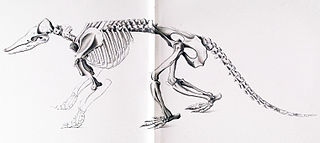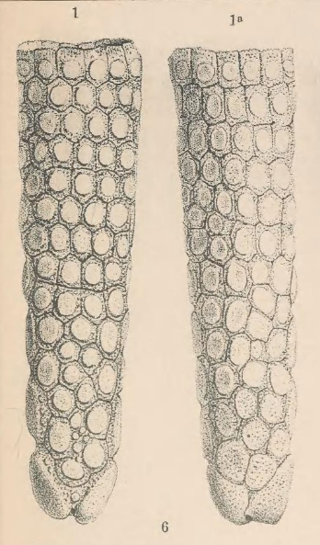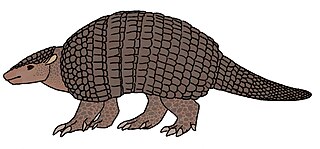
Hoplophorus is an extinct genus of glyptodont, a subfamily of armadillos. The only confidently known species was H. euphractus, found in Pleistocene deposits in Brazil, though fossils possibly from another species are known from Bolivia.
The Chasicoan age is a period of geologic time from 10–9 Ma within the Late Miocene epoch of the Neogene, used more specifically within the SALMA classification in South America. It follows the Mayoan and precedes the Huayquerian age.

Stegotherium is an extinct genus of long-nosed armadillo, belonging to the Dasypodidae family alongside the nine-banded armadillo. It is currently the only genus recognized as a member of the tribe Stegotheriini. It lived during the Early Miocene of Patagonia and was found in Colhuehuapian rocks from the Sarmiento Formation, Santacrucian rocks from the Santa Cruz Formation, and potentially also in Colloncuran rocks from the Middle Miocene Collón Curá Formation. Its strange, almost toothless and elongated skull indicates a specialization for myrmecophagy, the eating of ants, unique among the order Cingulata, which includes pampatheres, glyptodonts and all the extant species of armadillos.

Lomaphorus is a possibly dubious extinct genus of glyptodont that lived during the Pleistocene in eastern Argentina. Although many species have been referred, the genus itself is possibly dubious or synonymous with other glyptodonts like Neoslerocalyptus from the same region.
The Colorado Basin is a sedimentary basin located in northeastern Patagonia. The basin stretches across an area of approximately 180,000 square kilometres (69,000 sq mi), of which 37,000 square kilometres (14,000 sq mi) onshore in the southern Buenos Aires Province and the easternmost Río Negro Province extending offshore in the South Atlantic Ocean.
Utaetus is an extinct genus of mammal in the order Cingulata, related to the modern armadillos. The genus contains two species, Utaetus buccatus and U. magnum. It lived in the Late Paleocene to Late Eocene and its fossil remains were found in Argentina and Brazil in South America.
Kelenkura is an extinct genus of heavily armored mammals belonging to the subfamily Glyptodontinae, from the family Chlamyphoridae that contain most of the modern armadillos. It was a medium-sized South American animal, distantly related to Doedicurus. Fossils of this genus were recovered in the Arroyo Chasicó Formation and in the Loma de Las Tapias Formation of Argentina in rocks dating back to the Late Miocene epoch.
Typotheriopsis is an extinct genus of Notoungulate, belonging to the family Mesotheriidae, which included several small sized Meridiungulates specialized in digging. It is considered as the sister taxon of the clade including Mesotherium and Pseudotypotherium. Its fossils are known from the Chasicoan and the Huayquerian periods, notably among Late Miocene rocks from the Arroyo Chasicó Formation and the Cerro Azul Formation of Argentina.

Paedotherium is an extinct, potentially paraphyletic genus of Notoungulate, belonging to the family Hegetotheriidae, composed of small-sized, rodent or lagomorph-like South American ungulates. Four species are unambiguously recognized, from the Late Miocene to the Pleistocene of Argentina, and from the late Miocene of Bolivia and Chile.
Ronwolffia is an extinct genus of horned armadillo (Peltephilidae), distantly related to the modern species of armadillos and to the extinct glyptodonts. It lived during the Oligocene in what is now the Salla Formation in Bolivia.

Kraglievichia is an extinct genus of cingulate belonging to the family Pampatheriidae. It lived from the Late Miocene to the Early Pliocene, and its fossilized remains were discovered in South America.
Machlydotherium is an extinct genus of cingulate of uncertain systematic affinities, perhaps belonging to the Pampatheriidae. It lived from the Middle Eocene to the Early Oligocene, and its fossilized remains were found in South America.

Scirrotherium is an extinct genus of pampatheres, a family of herbivorous cingulates, related to the similar but smaller modern armadillos, and with the now extinct glyptodonts, well-known from their shell-like armor. Its scientific name is derived from the Greek prefix "skiros-", "cover", and the suffix "-therion, "beast", while the name of the type species, hondaensis, honors the town of Honda, in the Tolima Department of Colombia. Scirrotherium is one of several genera of xenarthrans found in the La Venta fauna, dated from the Middle Miocene.

Proeutatus is an extinct genus of xenarthran, belonging to the order Cingulata. It lived during the Early Miocene, and its fossilized remains were discovered in South America.
Proeuphractus is an extinct genus of xenarthran, related to the modern armadillos. It lived from the Early to the Late Miocene, and its fossilized remains were discovered in South America.

Prozaedyus is an extinct genus of chlamyphorid armadillo that lived during the Middle Oligocene and Middle Miocene in what is now South America.
Asterostemma is an extinct genus of glyptodont. It lived during the Middle Miocene, and its fossilized remains were discovered in South America.
Dasypus neogaeus is an extinct species of armadillo, belonging to the genus Dasypus, alongside the modern nine-banded armadillo. The only known fossil is a single osteoderm, though it has been lost, that was found in the Late Miocene strata of Argentina.
Chasicobradys is an extinct genus of ground sloths of the family Nothrotheriidae that lived in what is now Argentina. Chasicobradys was discovered in the Arroyo Chasicó Formation, in Buenos Aires Province. It is only known from jaw fragments and teeth, which allowed the identification of this species, and was classified as a member of the nothrotheriid subfamily Nothrotheriinae, which comprises small to medium-sized species of ground sloths.

Peltephilidae is a family of South American cingulates (armadillos) that lived for over 40 million years, but peaked in diversity towards the end of the Oligocene and beginning of the Miocene in what is now Argentina. They were exclusive to South America due to its geographic isolation at the time, one of many of the continent's strange endemic families. Peltephilids are one of the earliest known cingulates, diverging from the rest of Cingulata in the Early Eocene.











